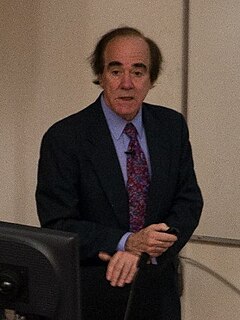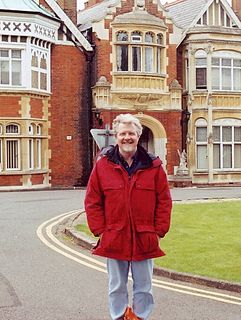Related Research Articles

Statistics is the discipline that concerns the collection, organization, analysis, interpretation, and presentation of data. In applying statistics to a scientific, industrial, or social problem, it is conventional, to begin with a statistical population or a statistical model to be studied. Populations can be diverse groups of people or objects such as "all people living in a country" or "every atom composing a crystal". Statistics deals with every aspect of data, including the planning of data collection in terms of the design of surveys and experiments.
In queueing theory, a discipline within the mathematical theory of probability, Little's result, theorem, lemma, law, or formula is a theorem by John Little which states that the long-term average number L of customers in a stationary system is equal to the long-term average effective arrival rate λ multiplied by the average time W that a customer spends in the system. Expressed algebraically the law is
Computational science, also known as scientific computing or scientific computation (SC), is a field in mathematics that uses advanced computing capabilities to understand and solve complex problems. It is an area of science that spans many disciplines, but at its core, it involves the development of models and simulations to understand natural systems.

Jeffrey Peter Buzen is an American computer scientist in system performance analysis best known for his contributions to queueing theory. His 1971 doctoral thesis Computational algorithms for closed queueing networks with exponential servers has guided the study of queueing network modeling.

Clifford Ivar Nass was a professor of communication at Stanford University, co-creator of The Media Equation theory, and a renowned authority on human-computer interaction (HCI). He was also known for his work on individual differences associated with media multitasking. Nass was the Thomas M. Storke Professor at Stanford and held courtesy appointments in Computer Science, Education, Law, and Sociology. He was also affiliated with the programs in Symbolic Systems and Science, Technology, and Society.
Kanianthra Mani Chandy is the Simon Ramo Professor of Computer Science at the California Institute of Technology (Caltech). He has been the Executive Officer of the Computer Science Department twice, and he has been a professor at Caltech since 1989. He also served as Chair of the Division of Engineering and Applied Science at the California Institute of Technology.

Michel Pierre Talagrand is a French mathematician. Docteur ès sciences since 1977, he has been, since 1985, Directeur de Recherches at CNRS and a member of the Functional Analysis Team of the Institut de Mathématique of Paris. Talagrand was elected as correspondent of the Académie des sciences of Paris in March 1997, and then as a full member in November 2004, in the Mathematics section.
In mathematical optimization, ordinal optimization is the maximization of functions taking values in a partially ordered set ("poset"). Ordinal optimization has applications in the theory of queuing networks.

Neil Gunther is a computer information systems researcher best known internationally for developing the open-source performance modeling software Pretty Damn Quick and developing the Guerrilla approach to computer capacity planning and performance analysis. He has also been cited for his contributions to the theory of large transients in computer systems and packet networks, and his universal law of computational scalability.
Lajos Takács was a Hungarian mathematician, known for his contributions to probability theory and in particular, queueing theory. He wrote over two hundred scientific papers and six books.
Onno Johan Boxma is a Dutch mathematician, and Professor at the Eindhoven University of Technology, known for several contributions to queueing theory and applied probability theory.
In queueing theory, a discipline within the mathematical theory of probability, quasireversibility is a property of some queues. The concept was first identified by Richard R. Muntz and further developed by Frank Kelly. Quasireversibility differs from reversibility in that a stronger condition is imposed on arrival rates and a weaker condition is applied on probability fluxes. For example, an M/M/1 queue with state-dependent arrival rates and state-dependent service times is reversible, but not quasireversible.

Applied mathematics is the application of mathematical methods by different fields such as physics, engineering, medicine, biology, finance, business, computer science, and industry. Thus, applied mathematics is a combination of mathematical science and specialized knowledge. The term "applied mathematics" also describes the professional specialty in which mathematicians work on practical problems by formulating and studying mathematical models.
In queueing theory, a discipline within the mathematical theory of probability, a fluid queue is a mathematical model used to describe the fluid level in a reservoir subject to randomly determined periods of filling and emptying. The term dam theory was used in earlier literature for these models. The model has been used to approximate discrete models, model the spread of wildfires, in ruin theory and to model high speed data networks. The model applies the leaky bucket algorithm to a stochastic source.
The following outline is provided as an overview of and topical guide to computing:
References
- ↑ The Mathematics Genealogy Project
- ↑ Computer Measurement Group A. A. Michelson Award Archived 2007-02-03 at the Wayback Machine
- ↑ Allen, Arnold O. (1990). Probability, Statistics, and Queueing Theory with Computer Science Applications, 2nd ed . Academic Press. ISBN 978-0-12-051051-1.
- ↑ Allen, Arnold O. (1994). "Introduction". Computer Performance Analysis with Mathematica. Academic Press. p. 1. ISBN 978-0-12-051070-2.
- ↑ Shaw, George Bernard (1903). "Maxims for Revolutionists". Man and Superman. Penguin Classics (2001). p. 251. ISBN 978-0-14-043788-1.